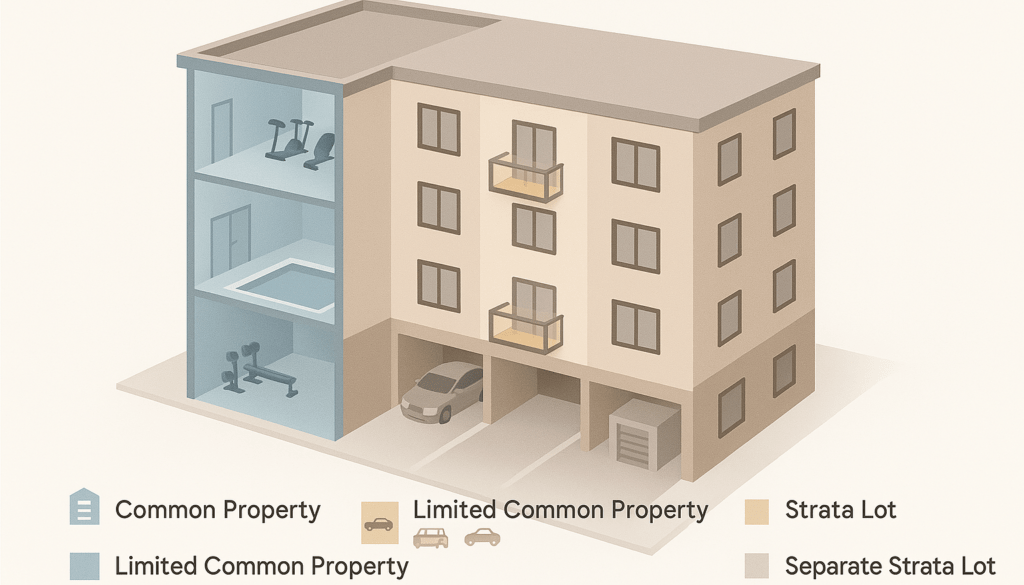Understanding Parking and Storage in Strata Properties: Common Property, Limited Common Property, and Strata Lots
When purchasing a strata property in British Columbia, one of the most critical considerations is the ownership and use of parking spaces and storage lockers. These spaces can be classified as common property, limited common property, part of a strata lot, or a separate strata lot. Understanding the distinctions is essential to avoid disputes and ensure proper use. Below is a breakdown of these classifications and how they impact ownership and rights.
-
Common Property
Common property refers to all areas of the strata corporation that are not designated as part of a strata lot or limited common property. This typically includes:
- Exterior walls, roofs, and shared plumbing systems
- Hallways, elevators, and lobbies
- Amenities such as pools, gyms, and gardens
- Some parking and storage areas
Since common property is owned collectively by all strata owners, decisions regarding its use, maintenance, or modifications must be made through the strata council or by a vote of all owners. Parking and storage spaces designated as common property may be assigned to owners on a short-term or long-term basis by the strata corporation, but ownership remains with the strata.
-
Limited Common Property (LCP)
Limited common property is a specific type of common property that is designated for the exclusive use of a particular strata lot or group of strata lots. Examples include:
- Balconies and patios assigned to specific units
- Parking stalls or storage lockers reserved for certain units
LCP remains under the ownership of the strata corporation, but the designated unit owners have exclusive rights to use it. The maintenance responsibilities for LCP are generally assigned to the strata lot owners who benefit from it, but significant repairs or alterations still require approval from the strata corporation.
-
Part of a Strata Lot
In some cases, a parking stall or storage locker is legally designated as part of a specific strata lot. This means:
- The owner of the strata lot has full ownership rights over the parking or storage space
- It is included in the square footage of the strata unit
- It can be sold, transferred, or mortgaged along with the unit
If a parking or storage space is part of a strata lot, it is considered private property, and the owner has control over its use. However, any alterations must still comply with the strata bylaws and regulations.
-
Separate Strata Lot
A parking stall or storage locker may also be designated as a separate strata lot. In this case:
- It has its own strata lot number and may have its own property taxes and strata fees
- It can be bought and sold independently of a residential strata unit (unless restrictions are in place)
- It may be subject to different bylaws compared to those governing residential units
Separate strata lots for parking and storage are more common in high-density developments where ownership of parking spaces is treated as a separate investment or amenity.
-
Parts of a Strata Lot with Different Uses
Some strata units have unique configurations where different parts of the unit serve different purposes. For example:
- A townhouse with a garage that is legally part of the strata lot but has specific usage restrictions
- A commercial strata unit with a designated customer parking area included as part of the strata lot
In these cases, the rules governing the use of different sections of the strata lot are typically outlined in the strata bylaws and registered strata plans.
Key Takeaways on the Understanding of the Terms and Types of Strata Property
- Before purchasing a strata property, it is essential to review the strata plan, bylaws, and other legal documents to confirm how parking and storage spaces are designated. Some key questions to ask include:
- Who owns the parking or storage space? Is it part of the strata lot, a separate strata lot, limited common property, or common property?
- What are the assignment rules? If the space is common property, does the strata council control assignments?
- Are there any restrictions? Are there rules regarding who can use the space, whether it can be leased, or if it can be sold separately?
- Who is responsible for maintenance? If the space is LCP, does the owner or the strata corporation handle upkeep?
Understanding the differences between common property, limited common property, and strata lots in a strata development is essential for making informed decisions about parking and storage. Since each strata corporation has its own rules and regulations, buyers should carefully review the strata documents and consult a real estate professional to avoid misunderstandings. Proper due diligence ensures that buyers secure the rights they expect and prevents disputes over property usage in the future.





